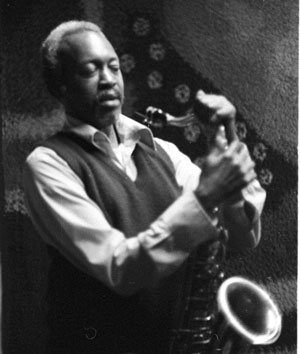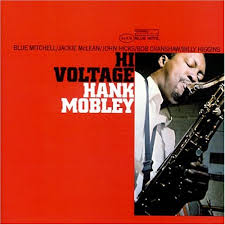High Voltage – Hank Mobley
Almost but not quite a blues, High Voltage is a great example of the gospel-infused soul-jazz of the '60s. A score and parts are available for the sextet arrangement.
- Recording: Hank Mobley - Hi Voltage
- Recorded on: October 9, 1967
- Label: Blue Note (BLP 4273)
- Concert Key: F
- Vocal Range: , to
- Style: Swing (medium up)
- Trumpet - Blue Mitchell
- Alto Sax - Jackie McLean
- Tenor Sax - Hank Mobley
- Piano - John Hicks
- Bass - Bob Cranshaw
- Drums - Billy Higgins
0:00
0:00
Buy MP3
Purchase High Voltage - Hank Mobley
Purchasing this song through our affiliate links with certain retailers provides jazzleadsheets.com with additional support to help keep us bringing you the best lead sheets available. Thank you!
Video
- Description
- Historical Notes
- Solos
- Piano Corner
- Bass Corner
- Drum Corner
- Guitar Corner
- Inside & Beyond
- Minus You
Classic soul-jazz with a high-voltage groove! This song is a bit faster than many iconic '60s soul-jazz songs in a similar style (including Hank Mobley's earlier The Turnaround), and the increased tempo gives High Voltage a notably "down home" gospel feeling. The groove is based on a two-measure vamp, with a rhythmic piano figure also doubled by the snare drum. The form is 24 measures long, but it's not quite a blues as it doesn't go to the IV chord. Instead, the first 16 measures stay on F7, followed by a simple V-IV-I turnaround. The melody is also quite simple, with long notes that allow the accompanying vamp figures to fill in around them.
Our lead sheets, which are also the 1st parts for the sextet arrangement, show the melody as trumpeter Blue Mitchell plays it on the first chorus of the in head. In the second chorus, and both repeats of the out head, he embellishes the A section melody phrases a bit while keeping the same phrase structure. We left Blue's pickup to the second chorus in the first ending as an inspiration to launch your own interpretation—he leads into C as the first note of the second chorus instead of F.
About the arrangement: A full set of parts, as well as a full score, are available for the sextet arrangement heard on the recording. The alto and tenor saxes double the rhythmic piano vamp figure both on the head and the eight-measure intro; in the first half of the B section all three horns are harmonized. There is a coda that goes to a different vamp, with the trumpet soloing over alto and tenor repeating a one-measure figure; the piano has a different two-measure figure here. On the recording, the alto and tenor vamp from the coda is also played by the trumpet and alto as a background for the tenor solo.
Our lead sheets, which are also the 1st parts for the sextet arrangement, show the melody as trumpeter Blue Mitchell plays it on the first chorus of the in head. In the second chorus, and both repeats of the out head, he embellishes the A section melody phrases a bit while keeping the same phrase structure. We left Blue's pickup to the second chorus in the first ending as an inspiration to launch your own interpretation—he leads into C as the first note of the second chorus instead of F.
About the arrangement: A full set of parts, as well as a full score, are available for the sextet arrangement heard on the recording. The alto and tenor saxes double the rhythmic piano vamp figure both on the head and the eight-measure intro; in the first half of the B section all three horns are harmonized. There is a coda that goes to a different vamp, with the trumpet soloing over alto and tenor repeating a one-measure figure; the piano has a different two-measure figure here. On the recording, the alto and tenor vamp from the coda is also played by the trumpet and alto as a background for the tenor solo.
"Hi Voltage" was recorded at the legendary Van Gelder Studio in Englewood Cliffs.
"Hi Voltage" was the third of five Blue Note albums that Blue Mitchell played on in 1967. Check out Tina Brooks' Medina for another song with Blue and Jackie McLean in a three-horn setting, from McLean's 1960 session issued on "Street Singer." Blue Mitchell's 1966 album "Bring It Home To Me," like "Hi Voltage," features Billy Higgins; it includes two songs—both Jimmy Heath compositions—with a similar gospel-infused groove like High Voltage.
"Hi Voltage" was the third of five Blue Note albums that Blue Mitchell played on in 1967. Check out Tina Brooks' Medina for another song with Blue and Jackie McLean in a three-horn setting, from McLean's 1960 session issued on "Street Singer." Blue Mitchell's 1966 album "Bring It Home To Me," like "Hi Voltage," features Billy Higgins; it includes two songs—both Jimmy Heath compositions—with a similar gospel-infused groove like High Voltage.
Our detailed piano, bass and drum parts show how the rhythm section plays on the recording.
Piano voicings are shown condensed on one staff. The voicings for the head are mostly notated except for the first three measures of B, which show the comping rhythms. Voicings for the coda are also included.
Our bass part is notated throughout the head. The bass holds down a two-feel for almost the whole song, only catching the rhythm section hits in the first half of B. Our drum part shows the snare pattern for the head, which largely lines up with the piano figures, though it is slightly different in the coda.
Piano voicings are shown condensed on one staff. The voicings for the head are mostly notated except for the first three measures of B, which show the comping rhythms. Voicings for the coda are also included.
Our bass part is notated throughout the head. The bass holds down a two-feel for almost the whole song, only catching the rhythm section hits in the first half of B. Our drum part shows the snare pattern for the head, which largely lines up with the piano figures, though it is slightly different in the coda.
Related Songs
Email Send High Voltage to a friend
Send this page to a friend via email. Add your name or email in the first field. In the second, add one or more email addresses, separated by a comma.

Hank Mobley
July 7, 1930 – May 30, 1986
Hank Mobley is one of the most acclaimed tenor saxophonists in modern jazz history. He is recognized by musicians and critics alike as one of the most important and eloquent jazz instrumentalists of all time. He recorded well over 100 of his own original compositions and left an indelible mark on the post-bop jazz scene. Read more...
There was a problem.
...

